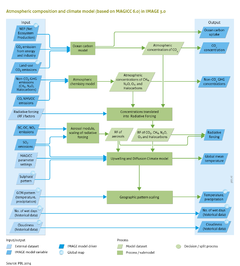Atmospheric composition and climate/Data uncertainties limitations: Difference between revisions
Jump to navigation
Jump to search
Oostenrijr (talk | contribs) m (Text replace - "CH4" to "CH<sub>4</sub>") |
Oostenrijr (talk | contribs) m (Text replace - "N2O" to "N<sub>2</sub>O") |
||
| Line 14: | Line 14: | ||
For CO2, there is a substantial uncertainty about how much carbon enters the ocean and the terrestrial biosphere, now and in the future, and how much remains in the atmosphere. The atmospheric concentrations of other greenhouse gases after the emission release is less uncertain and also less relevant because these gases contribute less to global climate change ([[Forster et al., 2007]]). | For CO2, there is a substantial uncertainty about how much carbon enters the ocean and the terrestrial biosphere, now and in the future, and how much remains in the atmosphere. The atmospheric concentrations of other greenhouse gases after the emission release is less uncertain and also less relevant because these gases contribute less to global climate change ([[Forster et al., 2007]]). | ||
In terms of radiative forcing, there is little uncertainty about the long-lived greenhouse gases (CO2, CH<sub>4</sub>, | In terms of radiative forcing, there is little uncertainty about the long-lived greenhouse gases (CO2, CH<sub>4</sub>, N<sub>2</sub>O, and halocarbons), but AR4 identified the largest uncertainties and lowest understanding for direct and indirect aerosol effects, albedo, and tropospheric ozone ([[Forster et al., 2007]]). | ||
IMAGE uses the mean values from AR4 as best estimates for all forcing agents ([[Forster et al., 2007]]). The uncertainty in change in global mean temperature, as derived from results of AOGCM calculations, is still quite large, with climate sensitivity likely to be in the range of 2 to 4.5 °C (with lower values very unlikely, and values above 4.5 not possible to exclude). Instead of using the best estimate of 3 °C ([[Randall et al., 2007]]), this uncertainty can be accounted for by emulating different AOGCMs with the MAGICC model. | IMAGE uses the mean values from AR4 as best estimates for all forcing agents ([[Forster et al., 2007]]). The uncertainty in change in global mean temperature, as derived from results of AOGCM calculations, is still quite large, with climate sensitivity likely to be in the range of 2 to 4.5 °C (with lower values very unlikely, and values above 4.5 not possible to exclude). Instead of using the best estimate of 3 °C ([[Randall et al., 2007]]), this uncertainty can be accounted for by emulating different AOGCMs with the MAGICC model. | ||
Revision as of 10:36, 1 July 2014
Parts of Atmospheric composition and climate/Data uncertainties limitations
| Component is implemented in: |
|
| Related IMAGE components |
| Projects/Applications |
| Models/Databases |
| Key publications |
| References |
